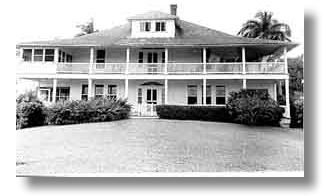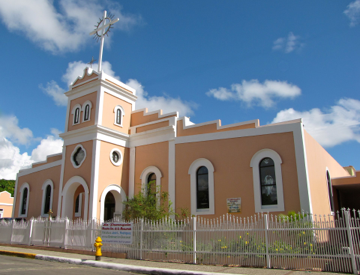
Salinas, Puerto Rico
Town of the Islander Dip

Salinas (sah-LEE-nahs) is known as “The town of the Island Mojo” and its residents are called the Marlins. “Mojo” is a sauce that is used to marinate fried fish and is made from a base of tomato sauce, oil, garlic, bay leaves and onion. The patron saint of the municipality is the Virgin of Monserrate.
Salinas is located on the southern coast of Puerto Rico. It is bordered on the north by the municipalities of Coamo, Aibonito and Cayey, on the south by the Caribbean Sea, on the west by the municipalities of Coamo and Santa Isabel and on the east by Guayama.
Geographically, Salinas is part of the sub-region called the Ponce-Patillas alluvial plain in the southern coastal plain region, which is formed by the consolidation of the valleys that descend southward from the central mountain range and the Cayey range. This region is one of the driest in Puerto Rico. Despite that, Salinas is known for its agricultural wealth.
Sugar cane played a fundamental role in the development of Salinas. The cane was processed in the Aguirre Central sugar mill, one of the last to cease operations on the island. Today, Salinas has factories that produce plastic and metal products, electrical and electronic equipment, clothing, fruit drinks and frames for lenses and eyeglasses. Other industries include fruit orchards, raising livestock, and fishing. Tourism is another source of income for the municipality.
Foundation:
Salinas was founded in 1851. The name is dereived from its great and abundant knolls of salt in its coasts. In 1842 the settlers of the area united to obtain authorization to found the town and to distribute the expenses needed to construct the necessary municipal works.
On July 15, 1847 a Royal Order dictated that Salinas be segregated from Coamo and be added to Guayama. The settlers continued their efforts and the town was founded on July 22, 1851, and was composed of the following wards: Ausubos or Lapa, Collado, Palmas, Quebrada Yeguas, Quebrada Honda, Río Jueyes and Salinas Town.
On March 1, 1902 the Legislative Assembly of Puerto Rico approved the Law for the Consolidation of Certain Municipal Terms by which it eliminated the municipality of Salinas and added it to Guayama as a ward. This situation remained until 1905, when a new law of the Legislative Assembly revoked the previous one and gave back to Salinas its character of municipality, with all the wards it had in 1902.
In 1948 the Aguirre ward was divided in Central Aguirre (Village), Coquí, San Felipe and Aguirre, increasing the metropolitan area.
For decades Salinas has been known as the "Town of the Islander Dip". This flavorful sauce (mojo) is used as a dip for the fried fish that is consumed in the area. The reddish mixture has as main ingredients tomato sauce, oil, garlic, laurel and abundant onion.
It is said that Salinas is where this delicious sauce was created. There is a version that says it was a native of the Canary Islands, nicknamed "El Isleño" (The Islander) who arrived at the Salinas beach and taught the playeros (beachcombers) how to prepare the sauce. But the most accepted version is the one about doña Euladia Correa, born in 1898 in the Playa ward, that with her most particular demanding formula attracted the palate of everybody to her humble native hut, and later on to her well-known restaurant, where the whole Island of Puerto Rico had the opportunity to taste the exquisite delicacy.
This exquisite delicacy was the cause for Salinas to be baptized as the "Town of the Islander Dip". The Department of Agriculture and Commerce granted a medal to doña Euladia Correa for her contribution to the promotion of the economy of the country.
Location:
 Salinas is located in the southern coast of the Island. It is bordered by: Coamo, Aibonito and Cayey to the north; the Caribbean Sea to the south; Coamo and Santa Isabel to the west; and Guayama to the east.
Salinas is located in the southern coast of the Island. It is bordered by: Coamo, Aibonito and Cayey to the north; the Caribbean Sea to the south; Coamo and Santa Isabel to the west; and Guayama to the east.
Area:
180.4 sq km / 69.4 sq mi
Population:
31,113 (census 2000)
Population Density:
172.4 per sq km / 448.3 per sq mi
People are known as:
Salinences
Salinas is also known as:
El Pueblo del Mojo Isleño (Town of the Islander Dip)
Los Marlins (The Marlins)
Wards: Sabana Grande, Puerto Rico

| Census 2000: Population by Wards - Salinas |
Habitants |
| Aguirre | 12,128 |
| Lapa | 9,697 |
| Palmas | 434 |
| Quebrada Yeguas | 1,596 |
| Río Jueyes | 4,027 |
| Salinas Town | 3,231 |
| Total | 31,113 |
Source: Censo 2000
Patron:
Nuestra Señora de la Monserrate
Nuestra Señora de la Monserrate Parish
Box 1172
Salinas, P.R. 00751
(787) 824-2215

Topography:
It belongs to the region of the Southern Coastal Plain. To the north it has elevations that belong to the Cayey Sierra, which many consider it as a prolongation of the Central Mountain Range.
Hydrography:
It is bathed by the Salina (Nigua), Jueyes, Lapa and Jájome rivers. The Pasto Viejo, Callao, La Palma y Majada gorges and the Punta Arctias and Mar Negro lagoons.
Economy:
One of its industries is the Aguirre Sugar Cane Mill, which is one of the few that is still in operation in Puerto Rico; the sugar cane has been, fundamental in its economic development. Other industries are those that elaborate metal and plastic products, electrical and electronic machinery, apparell, fruit juice and sunglasses. Fruit, cattle and commercial fishing are sources of income in addition to sugar cane.
Average Salary:
$312.13 weekly (1998)
Flag:
 On a green rectangular field, five white isosceles triangles equal in size, placed in the center of the flag and forming a row that covers the extent of the background. The triangles constitute a geometric vision of the salt knolls that appear in the shield.
On a green rectangular field, five white isosceles triangles equal in size, placed in the center of the flag and forming a row that covers the extent of the background. The triangles constitute a geometric vision of the salt knolls that appear in the shield.
Coat Of Arms:
 For the shield the the traditional colors of the town were chosen; green and silver.
For the shield the the traditional colors of the town were chosen; green and silver.
- The salt knolls indicate in graphical form the name of the town: Salinas.
- The fish refer to the fishing.
- The sugar cane leaves that surround the shield, symbolize the sugar cane plantations.
The shield is a symbolic way of indicating the occupations and industries, including salt extraction and fishing, that have been main factors in the origin and development of the population.
- The three tower crown is a symbol granted to all the towns founded during the Spanish domination.
Let it be understood that the four tower crowns in the shields of the towns are reserved for the title of Villa and the five tower ones for the title of City, both conferred by royal decree.
Places To Visit:
- Olympic Center
- Aguirre Forest
- Former Aguirre Central sugar mill
- Camp Santiago
- Museum of Sports
- Puerto Rico International Speedway
- Freshwater well
- Monument to Veterans
- Rincón Bay
- Artisans market
- Jagüeyes Forest
- Jobos Bay Estuarine Research National Preserve
Events:
- National Three Kings Day Procession – January
- Abey Carnival – February
- Fish Festival – June
- International Olympic Festival – June
- Island Mojo Festival – July
- Virgen de la Monserrate Patron Saint Festival – September
- Christmas Festival – December
Beaches:
- Salinas Beach
- Santa Isabel Beach
- Jauca Beach - Jauca Bay
- Cayo Matias Beach
- Ochenta Beach
- Clavellina Beach
Distinguished Citizens:
- Jesús María Amadeo – Physician, novelist and playwright.
- Rafael Esparra Cartagena – Public servant. In 1980, he was named special assistant to the Mayor of New York. In 1984 he was named deputy commissioner of the New York Fire Department and, in 1997, he became president of the Brooklyn Navy Yard Development. He has been recognized on various occasions for his professional and civic work.
- Melvin Rodríguez Rodríguez – Painter and artist. His works focus on religious imagery. He has also created films, all of them made in Puerto Rico.
Public Schools sorted by educational levels.
Salinas Distict
| Name | Level | Telephone | Address |
| COQUÍ | Elementary | (787) 853-2636 | PO Box 157 |
| FRANCISCO MARIANO QUIÑONES | Elementary | (787) 824-4260 | PO Box 184 |
| GUILLERMO GODREAU MANATAU | Elementary | (787) 824-2610 | PO Box 802 |
| GUILLERMO GONZÁLEZ (PLAYITA) | Elementary | (787) 824-4748 | PO Box 184 |
| JOSÉ PADÍN | Elementary | (787) 824-7955 | PO Box 1156 |
| LAS MAREAS | Elementary | (787) 864-4727 | PO Box 2034 |
| LAS OCHENTAS | Elementary | (787) 824-4717 | PO Box 184 |
| PARCELAS COCO | Elementary | (787) 824-4265 | PO Box 6001 Suite 057 |
| PARCELAS VÁZQUEZ | Elementary | (787) 824-5568 | PO Box 501 |
| ROMÁN BALDORIOTY DE CASTRO | Elementary | (787) 824-2700 | PO Box 1156 |
| SAN FELIPE | Elementary | (787) 853-2125 | PO Box 2034 |
| SANTIAGO R. PALMER | Elementary | (787) 824-2350 | PO Box 1156 |
| VICTORIA SANTIAGO | Elementary | (787) 824-6161 | PO Box 501 |
| WOODROW WILSON | Elementary | (787) 853-2790 | Calle Principal Carr. 705 |
| COQUÍ (INTERMEDIA) | Intermediate | (787) 853-4800 | PO Box 2 |
| INTERMEDIA URBANA SALINAS | Intermediate | (787) 824-3306 | PO Box 1156 |
| SABANA LLANA INTERMEDIA | Intermediate | (787) 824-0896 | PO Box 1156 |
| ALBERGUE OLÍMPICO | Secondary | (787) 824-1534 | PO Box 2004 |
| LUIS MUÑOZ RIVERA | High School | (787) 824-2470 | PO Box 903 |
| STELLA MÁRQUEZ | High School | (787) 824-3357 | PO Box 1156 |
Hymn:
By Antonio Ferrer Atilano
Salinas, Salinas
el pueblo donde yo nací
sus campos sus montes
son siempre verdes para mí
Salinas, Salinas
yo no te puedo olvidar
tus bellos palmares
te saludan con una canción

